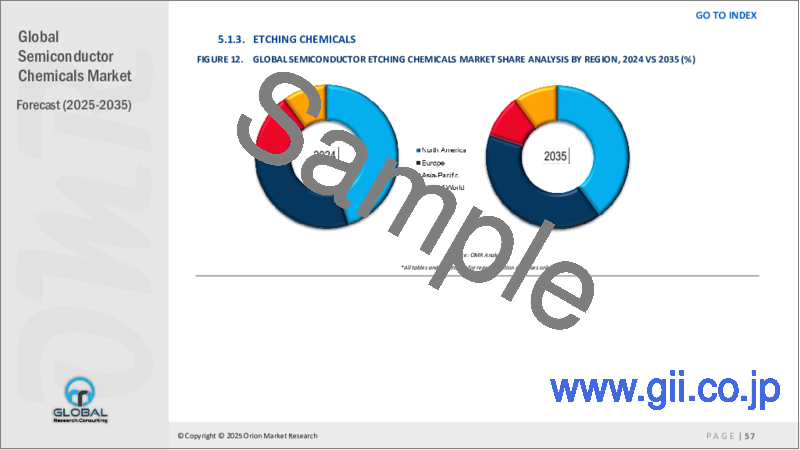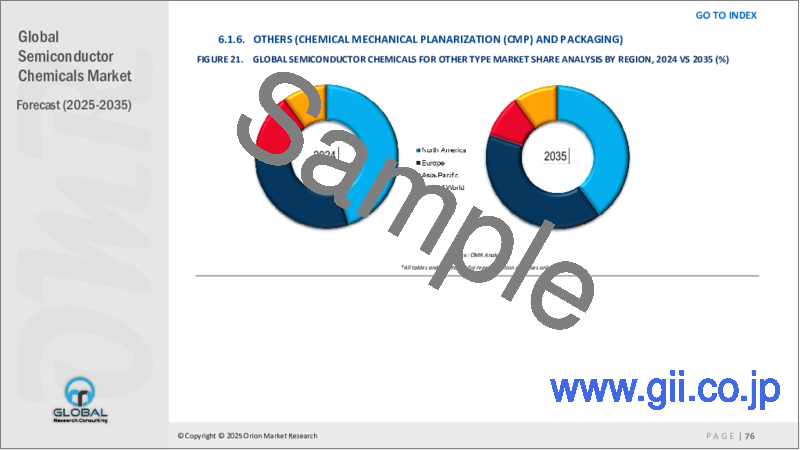|
|
市場調査レポート
商品コード
1433316
半導体用化学品の世界市場:2023-2030年Global Semiconductor Chemicals Market 2023-2030 |
||||||
カスタマイズ可能
|
|||||||
| 半導体用化学品の世界市場:2023-2030年 |
|
出版日: 2023年12月08日
発行: Orion Market Research
ページ情報: 英文 240 Pages
納期: 2~3営業日
|
- 全表示
- 概要
- 図表
- 目次
半導体用化学品の世界市場は、予測期間(2023-2030年)にCAGR11.8%で成長すると予測されています。半導体用化学品は、半導体の性能を高める物質であり、特定の条件下で電気を通すことができる固体化合物です。家電、自動車、データセンターなど幅広い用途で、AIやMLチップなどの先端半導体デバイスの需要が増加していることが、市場成長の主な要因となっています。先端半導体デバイスは、従来の半導体デバイスよりも複雑な製造工程を必要とし、より多くの半導体用化学品を使用します。さらに、先端半導体デバイスは、窒化ガリウム(GaN)や炭化ケイ素(SiC)などの新しい半導体材料を使用して製造されることが多く、従来の半導体材料とは異なる半導体用化学品を必要とします。
スマートフォン、ノートパソコン、テレビなどの家電機器はますます高機能化し、より高性能な半導体デバイスが必要とされています。例えば、AIチップはスマートフォンで顔認識や自然言語処理などのタスクに使用されています。MLチップは、画像や映像処理などのタスクのためにテレビに使用されています。自動運転車やADAS(先進運転支援システム)などの車載アプリケーションでは、AIチップやMLチップを含む幅広い半導体デバイスが必要とされます。これらのデバイスは、物体検出、車線維持、アダプティブ・クルーズ・コントロールなどのタスクに使用されます。インターネットやクラウドコンピューティングに使用されるデータセンターは、先進的な半導体デバイスへの依存度を高めています。AIチップやMLチップは、機械翻訳、画像認識、自然言語処理などのタスクに使用されます。
セグメント別の展望
フォトレジストが半導体用化学品の世界市場で大きなシェアを占めると予測
用途別では、フォトレジスト・サブセグメントが世界の半導体用化学品市場で大きなシェアを占めると予想されています。フォトレジストは、半導体ウエハー上にパターンを形成するために使用される感光性材料です。フォトレジストはウエハーに塗布された後、マスクを通して光に露光されます。露光されたフォトレジストは除去され、ウエハー上にパターンが残る。このパターンを使ってウエハーをエッチングし、目的の半導体デバイスを作る。この分野の成長は様々な理由によるものです。フォトレジストは半導体製造工程に不可欠な材料です。すべての半導体デバイスは、その構造と機能を定義するパターンを作成するためにフォトレジストを必要とします。フォトレジスト市場は非常に集中しており、少数の大手企業が市場を独占しています。そのため、大手企業は価格を設定し、フォトレジストの供給をコントロールすることができます。フォトレジスト市場は比較的成熟しており、半導体用化学品市場の他のセグメントと比べると、技術革新が少ないです。このため、新規参入企業が市場で競争するのは難しいです。
地域別展望
半導体用化学品の世界市場は、北米(米国、カナダ)、欧州(英国、イタリア、スペイン、ドイツ、フランス、その他欧州地域)、アジア太平洋地域(インド、中国、日本、韓国、その他アジア地域)、世界のその他の地域(中東とアフリカ、ラテンアメリカ)を含む地域別にさらに細分化されます。このうち、アジア太平洋地域は、全世界の市場で突出したシェアを占めると予想されています。アジア太平洋地域が半導体用化学品市場で最大のシェアを占める理由はいくつかあります。アジア太平洋地域はエレクトロニクス製造の主要拠点です。同地域では、スマートフォン、ノートパソコン、テレビなど幅広いエレクトロニクス製品が生産されています。エレクトロニクス製造業界は、半導体用化学品の主要な消費者です。
北米地域は世界の半導体用化学品市場において著しいCAGRで成長すると予想されます。
すべての地域の中で、北米地域は予測期間中にかなりのCAGRで成長すると予想されています。北米地域は半導体研究開発の主要拠点です。同地域の大学や研究機関は、半導体新技術開発の最前線にあります。北米地域は電子機器製造業が盛んです。当地域では、コンピューター、サーバー、ネットワーキング機器など、幅広いエレクトロニクス製品が生産されています。エレクトロニクス製造業界は、半導体用化学品の主要消費者です。 北米地域には、インテル、マイクロン・テクノロジー、クアルコムといった世界最大級の半導体メーカーがあります。これらの企業は、半導体用化学品の主要な消費者です。
目次
第1章 レポート概要
- 業界の現状分析と成長可能性の展望
- 調査方法とツール
- 市場内訳
- セグメント別
- 地域別
第2章 市場概要と洞察
- 調査範囲
- アナリストの洞察と現在の市場動向
- 主な調査結果
- 推奨事項
- 結論
第3章 競合情勢
- 主要企業分析
- BASF SE
- 概要
- 財務分析
- SWOT分析
- 最近の動向
- The Dow Chemical Co.
- 会社概要
- 財務分析
- SWOT分析
- 最近の動向
- DuPont de Nemours, Inc.
- 会社概要
- 財務分析
- SWOT分析
- 最近の動向
- Entegris
- 会社概要
- 財務分析
- SWOT分析
- 最近の動向
- Lam Research Corp.
- 会社概要
- 財務分析
- SWOT分析
- 最近の動向
- 主要戦略分析
第4章 市場セグメンテーション
- 半導体用化学品の世界市場:タイプ別
- 洗浄薬品
- 蒸着薬品
- エッチング薬品
- フォトレジスト薬品
- その他(ドーピング薬品、CMPスラリー、導電性ポリマー)
- 半導体用化学品の世界市場:用途別
- フォトレジスト
- エッチング
- 蒸着
- 洗浄
- ドーピング
- その他(CMPおよびパッケージング)
第5章 地域分析
- 北米
- 米国
- カナダ
- 欧州
- 英国
- ドイツ
- イタリア
- スペイン
- フランス
- その他欧州
- アジア太平洋
- 中国
- インド
- 日本
- 韓国
- その他アジア太平洋地域
- 世界のその他の地域
第6章 企業プロファイル
- Air Products and Chemicals, Inc.
- Asahi Kasei Corp.
- FUJIFILM Corp.
- Heraeus Grp.
- Hitachi High-Tech Corp.
- JSR Corp.
- Kanto Denka Kogyo Co., Ltd.
- LG Chem, Ltd.
- Merck Grp.
- Mitsubishi Chemical Corp.
- Nippon Shokubai Co., Ltd.
- SAMSUNG SDI CO., LTD.
- Shin-Etsu Chemical Co., Ltd.
- Shin-Etsu Chemical Co., Ltd.
- SK Siltron Co., Ltd.
- Sumitomo Chemical Co., Ltd.
- Tokuyama Corp.
- Tokyo Ohka Kogyo Co., Ltd.
- TOSHIBA MATERIALS CO., LTD.
- Umicore
LIST OF TABLES
- 1. GLOBAL SEMICONDUCTOR CHEMICALS MARKET RESEARCH AND ANALYSIS BY TYPE, 2023-2030 ($ MILLION)
- 2. GLOBAL SEMICONDUCTOR CHEMICALS BY CLEANING CHEMICALS MARKET RESEARCH AND ANALYSIS BY REGION, 2023-2030 ($ MILLION)
- 3. GLOBAL SEMICONDUCTOR CHEMICALS BY DEPOSITION CHEMICALS MARKET RESEARCH AND ANALYSIS BY REGION, 2023-2030 ($ MILLION)
- 4. GLOBAL SEMICONDUCTOR CHEMICALS BY ETCHING CHEMICALS MARKET RESEARCH AND ANALYSIS BY REGION, 2023-2030 ($ MILLION)
- 5. GLOBAL SEMICONDUCTOR CHEMICALS BY PHOTORESIST CHEMICALS MARKET RESEARCH AND ANALYSIS BY REGION, 2023-2030 ($ MILLION)
- 6. GLOBAL SEMICONDUCTOR CHEMICALS BY OTHERS MARKET RESEARCH AND ANALYSIS BY REGION, 2023-2030 ($ MILLION)
- 7. GLOBAL SEMICONDUCTOR CHEMICALS MARKET RESEARCH AND ANALYSIS BY APPLICATION, 2023-2030 ($ MILLION)
- 8. GLOBAL SEMICONDUCTOR CHEMICALS IN PHOTORESIST MARKET RESEARCH AND ANALYSIS BY REGION, 2023-2030 ($ MILLION)
- 9. GLOBAL SEMICONDUCTOR CHEMICALS IN ETCHING MARKET RESEARCH AND ANALYSIS BY REGION, 2023-2030 ($ MILLION)
- 10. GLOBAL SEMICONDUCTOR CHEMICALS IN DEPOSITION MARKET RESEARCH AND ANALYSIS BY REGION, 2023-2030 ($ MILLION)
- 11. GLOBAL SEMICONDUCTOR CHEMICALS IN CLEANING MARKET RESEARCH AND ANALYSIS BY REGION, 2023-2030 ($ MILLION)
- 12. GLOBAL SEMICONDUCTOR CHEMICALS IN DOPING MARKET RESEARCH AND ANALYSIS BY REGION, 2023-2030 ($ MILLION)
- 13. GLOBAL SEMICONDUCTOR CHEMICALS FOR OTHERS MARKET RESEARCH AND ANALYSIS BY REGION, 2023-2030 ($ MILLION)
- 14. GLOBAL SEMICONDUCTOR CHEMICALS MARKET RESEARCH AND ANALYSIS BY REGION, 2023-2030 ($ MILLION)
- 15. NORTH AMERICAN SEMICONDUCTOR CHEMICALS MARKET RESEARCH AND ANALYSIS BY COUNTRY, 2023-2030 ($ MILLION)
- 16. NORTH AMERICAN SEMICONDUCTOR CHEMICALS MARKET RESEARCH AND ANALYSIS BY TYPE, 2023-2030 ($ MILLION)
- 17. NORTH AMERICAN SEMICONDUCTOR CHEMICALS MARKET RESEARCH AND ANALYSIS BY APPLICATION, 2023-2030 ($ MILLION)
- 18. EUROPEAN SEMICONDUCTOR CHEMICALS MARKET RESEARCH AND ANALYSIS BY COUNTRY, 2023-2030 ($ MILLION)
- 19. EUROPEAN SEMICONDUCTOR CHEMICALS MARKET RESEARCH AND ANALYSIS BY TYPE, 2023-2030 ($ MILLION)
- 20. EUROPEAN SEMICONDUCTOR CHEMICALS MARKET RESEARCH AND ANALYSIS BY APPLICATION, 2023-2030 ($ MILLION)
- 21. ASIA- PACIFIC SEMICONDUCTOR CHEMICALS MARKET RESEARCH AND ANALYSIS BY COUNTRY, 2023-2030 ($ MILLION)
- 22. ASIA- PACIFIC SEMICONDUCTOR CHEMICALS MARKET RESEARCH AND ANALYSIS BY TYPE, 2023-2030 ($ MILLION)
- 23. ASIA- PACIFIC SEMICONDUCTOR CHEMICALS MARKET RESEARCH AND ANALYSIS BY APPLICATION, 2023-2030 ($ MILLION)
- 24. REST OF THE WORLD SEMICONDUCTOR CHEMICALS MARKET RESEARCH AND ANALYSIS BY COUNTRY, 2023-2030 ($ MILLION)
- 25. REST OF THE WORLD SEMICONDUCTOR CHEMICALS MARKET RESEARCH AND ANALYSIS BY TYPE, 2023-2030 ($ MILLION)
- 26. REST OF THE WORLD SEMICONDUCTOR CHEMICALS MARKET RESEARCH AND ANALYSIS BY APPLICATION, 2023-2030 ($ MILLION)
LIST OF FIGURES
- 1. GLOBAL SEMICONDUCTOR CHEMICALS MARKET SHARE BY TYPE, 2023 VS 2030 (%)
- 2. GLOBAL SEMICONDUCTOR CHEMICALS BY CLEANING CHEMICALS MARKET SHARE BY REGION, 2023 VS 2030 (%)
- 3. GLOBAL SEMICONDUCTOR CHEMICALS BY DEPOSITION CHEMICALS MARKET SHARE BY REGION, 2023 VS 2030 (%)
- 4. GLOBAL SEMICONDUCTOR CHEMICALS BY ETCHING CHEMICALS MARKET SHARE BY REGION, 2023 VS 2030 (%)
- 5. GLOBAL SEMICONDUCTOR CHEMICALS BY PHOTORESIST CHEMICALS MARKET SHARE BY REGION, 2023 VS 2030 (%)
- 6. GLOBAL SEMICONDUCTOR CHEMICALS BY OTHERS MARKET SHARE BY REGION, 2023 VS 2030 (%)
- 7. GLOBAL SEMICONDUCTOR CHEMICALS MARKET SHARE ANALYSIS BY APPLICATION, 2023-2030 ($ MILLION)
- 8. GLOBAL SEMICONDUCTOR CHEMICALS IN PHOTORESIST MARKET SHARE BY REGION, 2023 VS 2030 (%)
- 9. GLOBAL SEMICONDUCTOR CHEMICALS IN ETCHING MARKET SHARE BY REGION, 2023 VS 2030 (%)
- 10. GLOBAL SEMICONDUCTOR CHEMICALS IN DEPOSITION MARKET SHARE BY REGION, 2023 VS 2030 (%)
- 11. GLOBAL SEMICONDUCTOR CHEMICALS IN CLEANING MARKET SHARE BY REGION, 2023 VS 2030 (%)
- 12. GLOBAL SEMICONDUCTOR CHEMICALS IN DOPING MARKET SHARE BY REGION, 2023 VS 2030 (%)
- 13. GLOBAL SEMICONDUCTOR CHEMICALS FOR OTHERS MARKET SHARE BY REGION, 2023 VS 2030 (%)
- 14. GLOBAL SEMICONDUCTOR CHEMICALS MARKET SHARE BY REGION, 2023 VS 2030 (%)
- 15. US SEMICONDUCTOR CHEMICALS MARKET SIZE, 2023-2030 ($ MILLION)
- 16. CANADA SEMICONDUCTOR CHEMICALS MARKET SIZE, 2023-2030 ($ MILLION)
- 17. UK SEMICONDUCTOR CHEMICALS MARKET SIZE, 2023-2030 ($ MILLION)
- 18. FRANCE SEMICONDUCTOR CHEMICALS MARKET SIZE, 2023-2030 ($ MILLION)
- 19. GERMANY SEMICONDUCTOR CHEMICALS MARKET SIZE, 2023-2030 ($ MILLION)
- 20. ITALY SEMICONDUCTOR CHEMICALS MARKET SIZE, 2023-2030 ($ MILLION)
- 21. SPAIN SEMICONDUCTOR CHEMICALS MARKET SIZE, 2023-2030 ($ MILLION)
- 22. REST OF EUROPE SEMICONDUCTOR CHEMICALS MARKET SIZE, 2023-2030 ($ MILLION)
- 23. INDIA SEMICONDUCTOR CHEMICALS MARKET SIZE, 2023-2030 ($ MILLION)
- 24. CHINA SEMICONDUCTOR CHEMICALS MARKET SIZE, 2023-2030 ($ MILLION)
- 25. JAPAN SEMICONDUCTOR CHEMICALS MARKET SIZE, 2023-2030 ($ MILLION)
- 26. SOUTH KOREA SEMICONDUCTOR CHEMICALS MARKET SIZE, 2023-2030 ($ MILLION)
- 27. REST OF ASIA-PACIFIC SEMICONDUCTOR CHEMICALS MARKET SIZE, 2023-2030 ($ MILLION)
- 28. REST OF THE WORLD SEMICONDUCTOR CHEMICALS MARKET SIZE, 2023-2030 ($ MILLION)
Global Semiconductor Chemicals Market Size, Share & Trends Analysis Report by Type (Cleaning Chemicals, Deposition Chemicals, Etching Chemicals, Photoresist Chemicals, and Others), and by Application (Photoresist, Etching, Deposition, Cleaning, Doping, and Others), Forecast Period (2023-2030)
The global semiconductor chemicals market is projected to grow at a compound annual growth rate (CAGR) of 11.8% during the forecast period (2023-2030). Semiconductor chemicals are substances that enhance the performance of semiconductors, which are solid chemical compounds that can conduct electricity under certain conditions. Increasing demand for advanced semiconductor devices, such as AI and ML chips, across a wide range of applications, including consumer electronics, automotive, and data centers, is a key driver of market growth. Advanced semiconductor devices require more complex manufacturing processes and use more semiconductor chemicals than traditional semiconductor devices. Additionally, advanced semiconductor devices are often made using new semiconductor materials, such as gallium nitride (GaN) and silicon carbide (SiC), which require different semiconductor chemicals than traditional semiconductor materials.
Consumer electronics devices, such as smartphones, laptops, and televisions, are becoming increasingly sophisticated and require more powerful semiconductor devices. For example, AI chips are used in smartphones for tasks such as facial recognition and natural language processing. ML chips are used in televisions for tasks such as image and video processing. Automotive applications, such as self-driving cars and advanced driver assistance systems (ADAS), require a wide range of semiconductor devices, including AI chips and ML chips. These devices are used for tasks such as object detection, lane keeping, and adaptive cruise control. Data centers, which are used to power the internet and cloud computing, are increasingly reliant on advanced semiconductor devices. AI chips and ML chips are used for tasks such as machine translation, image recognition, and natural language processing.
Segmental Outlook
The global Semiconductor Chemicals market is segmented by type and applications. Based on the Type, the market is sub-segmented into cleaning chemicals, deposition chemicals, etching chemicals, photoresist chemicals, and others. Further, based on applications, the market is sub-segmented into photoresist, etching, deposition, cleaning, doping, and others.
The Photoresist Sub-Segment is Anticipated to Hold a Considerable Share of the Global Semiconductor Chemicals Market
Among the Applications, the Photoresist sub-segment is expected to hold a considerable share of the global Semiconductor Chemicals market. The photoresist is a light-sensitive material that is used to create patterns on semiconductor wafers. The photoresist is applied to the wafer and then exposed to light through a mask. The exposed photoresist is removed, leaving a pattern on the wafer. This pattern is then used to etch the wafer, creating the desired semiconductor device. The growth of the segment is due to various reasons. The photoresist is an essential material in the semiconductor manufacturing process. All semiconductor devices require photoresists to create the patterns that define their structure and function. The photoresist market is highly concentrated, with a few major players dominating the market. This allows the major players to set prices and control the supply of photoresists. The photoresist market is relatively mature, and there is less innovation in the market than in other segments of the semiconductor chemicals market. This makes it difficult for new entrants to compete in the market.
Regional Outlook
The global semiconductor chemicals market is further segmented based on geography including North America (the US, and Canada), Europe (UK, Italy, Spain, Germany, France, and the Rest of Europe), Asia-Pacific (India, China, Japan, South Korea, and Rest of Asia), and the Rest of the World (the Middle East & Africa, and Latin America. Among these, Asia-Pacific is anticipated to hold a prominent share of the market across the globe. There are several reasons why the Asia Pacific region holds the largest market share in the semiconductor chemicals market. The Asia Pacific region is a major hub for electronics manufacturing. The region produces a wide range of electronics products, such as smartphones, laptops, and televisions. The electronics manufacturing industry is a major consumer of semiconductor chemicals.
The North American Region is Expected to Grow at a Significant CAGR in the Global Semiconductor Chemicals Market
Among all regions, the North American region is anticipated to grow at a considerable CAGR over the forecast period. The North American region is a major hub for semiconductor research and development. The region's universities and research institutions are at the forefront of developing new semiconductor technologies. The North American region has a strong electronics manufacturing industry. The region produces a wide range of electronics products, such as computers, servers, and networking equipment. The electronics manufacturing industry is a major consumer of semiconductor chemicals. The North American region is home to some of the world's largest semiconductor manufacturers, such as Intel, Micron Technology, and Qualcomm. These companies are the primary consumers of semiconductor chemicals.
Market Players Outlook
The major companies serving the semiconductor chemicals market include BASF SE, The Dow Chemical Co., DuPont de Nemours, Inc., Entegris, Lam Research Corp., and others. The market players are considerably contributing to the market growth by the adoption of various strategies including mergers and acquisitions, partnerships, collaborations, funding, and new product launches, to stay competitive in the market. For instance, in April 2023 Ami Organics ventured into the semiconductor industry. Ami Organics Limited, the manufacturer of advanced pharmaceutical intermediates and specialty chemicals, announced its venture into the semiconductor industry following a board nod for the acquisition of a 55 % partnership interest in Baba Fine Chemicals (BFC).
The Report Covers:
- Market value data analysis of 2022 and forecast to 2030.
- Annualized market revenues ($ million) for each market segment.
- Country-wise analysis of major geographical regions.
- Key companies operating in the global semiconductor chemicals market. Based on the availability of data, information related to new product launches, and relevant news is also available in the report.
- Analysis of business strategies by identifying the key market segments positioned for strong growth in the future.
- Analysis of market-entry and market expansion strategies.
- Competitive strategies by identifying 'who-stands-where' in the market.
Table of Contents
1. Report Summary
- Current Industry Analysis and Growth Potential Outlook
- 1.1. Research Methods and Tools
- 1.2. Market Breakdown
- 1.2.1. By Segments
- 1.2.2. By Region
2. Market Overview and Insights
- 2.1. Scope of the Report
- 2.2. Analyst Insight & Current Market Trends
- 2.2.1. Key Findings
- 2.2.2. Recommendations
- 2.2.3. Conclusion
3. Competitive Landscape
- 3.1. Key Company Analysis
- 3.2. BASF SE
- 3.2.1. Overview
- 3.2.2. Financial Analysis
- 3.2.3. SWOT Analysis
- 3.2.4. Recent Developments
- 3.3. The Dow Chemical Co.
- 3.3.1. Overview
- 3.3.2. Financial Analysis
- 3.3.3. SWOT Analysis
- 3.3.4. Recent Developments
- 3.4. DuPont de Nemours, Inc.
- 3.4.1. Overview
- 3.4.2. Financial Analysis
- 3.4.3. SWOT Analysis
- 3.4.4. Recent Developments
- 3.5. Entegris
- 3.5.1. Overview
- 3.5.2. Financial Analysis
- 3.5.3. SWOT Analysis
- 3.5.4. Recent Developments
- 3.6. Lam Research Corp.
- 3.6.1. Overview
- 3.6.2. Financial Analysis
- 3.6.3. SWOT Analysis
- 3.6.4. Recent Developments
- 3.7. Key Strategy Analysis
4. Market Segmentation
- 4.1. Global Semiconductor Chemicals Market by Type
- 4.1.1. Cleaning chemicals
- 4.1.2. Deposition chemicals
- 4.1.3. Etching chemicals
- 4.1.4. Photoresist chemicals
- 4.1.5. Others (Doping chemicals, CMP slurries, and Conductive Polymers)
- 4.2. Global Semiconductor Chemicals Market by Application
- 4.2.1. Photoresist
- 4.2.2. Etching
- 4.2.3. Deposition
- 4.2.4. Cleaning
- 4.2.5. Doping
- 4.2.6. Others (Chemical Mechanical Planarization (CMP) and Packaging)
5. Regional Analysis
- 5.1. North America
- 5.1.1. United States
- 5.1.2. Canada
- 5.2. Europe
- 5.2.1. UK
- 5.2.2. Germany
- 5.2.3. Italy
- 5.2.4. Spain
- 5.2.5. France
- 5.2.6. Rest of Europe
- 5.3. Asia-Pacific
- 5.3.1. China
- 5.3.2. India
- 5.3.3. Japan
- 5.3.4. South Korea
- 5.3.5. Rest of Asia-Pacific
- 5.4. Rest of the World
6. Company Profiles
- 6.1. Air Products and Chemicals, Inc.
- 6.2. Asahi Kasei Corp.
- 6.3. FUJIFILM Corp.
- 6.4. Heraeus Grp.
- 6.5. Hitachi High-Tech Corp.
- 6.6. JSR Corp.
- 6.7. Kanto Denka Kogyo Co., Ltd.
- 6.8. LG Chem, Ltd.
- 6.9. Merck Grp.
- 6.10. Mitsubishi Chemical Corp.
- 6.11. Nippon Shokubai Co., Ltd.
- 6.12. SAMSUNG SDI CO., LTD.
- 6.13. Shin-Etsu Chemical Co., Ltd.
- 6.14. Shin-Etsu Chemical Co., Ltd.
- 6.15. SK Siltron Co., Ltd.
- 6.16. Sumitomo Chemical Co., Ltd.
- 6.17. Tokuyama Corp.
- 6.18. Tokyo Ohka Kogyo Co., Ltd.
- 6.19. TOSHIBA MATERIALS CO., LTD.
- 6.20. Umicore






